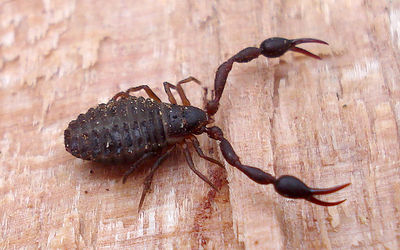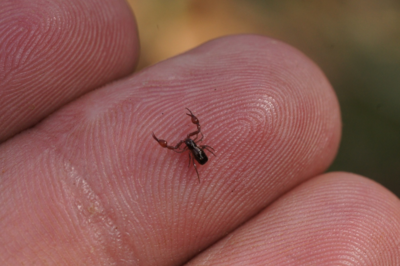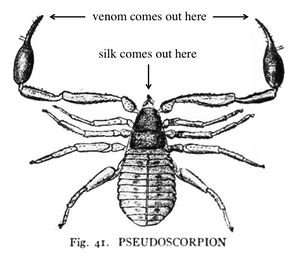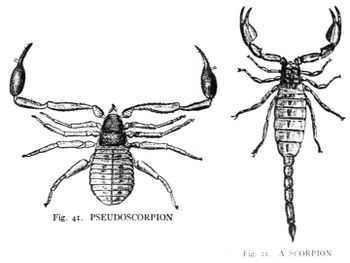Pseudoscorpions
Overview


Pseudoscorpions are an order of the class belonging to arachnida., related to ticks, mites, scorpions, and spiders. Thus, pseudoscorpions are joint-legged and are invertebrates. They have eight legs and also have relatively large pedipalps, compared to their overall size. Pedipalps are almost like claws, or pinchers, strongly resembling those of a scorpion. The size of these animals are very small, about 2-8 millimeters in length. [1] Because of their small size, they often go unnoticed, despite the fact that they live in many different environments. Pseudoscorpions are not harmful. In fact, they eat many small arthropods, helping with pest control. [1] There are over 3,300 known species, and 200 in north America. [4]
Classification
Kingdom- Animalia (Animals) Phylum- Arthropoda (Arthropods) Subphylum- Chelicerata (Chelicerates) Class- Arachnida (Arachnids) Order- Pseudoscorpiones (Pseudoscorpions)
Characteristics and Morphology
- A common house pseudoscorpion is usually between three and four millimeters.
- Color: yellowish to a brown
- Body: 12- segment abdomen, which only 10 are visible. These segments are protected by plates made of chitin.
- Shape: flat teardrop or pear like shaped body
- Pedipalps: Claw like. over twice the length of their legs. If they were completely extended, they would measure about seven to nine millimeters across. [1]
- Making up their pedipalps is an immobile hand and a finger. Separate moveable fingers are controlled by the adductor muscles. A venom gland and venom duct are usually also located in the mobile finger. This venom is used during hunting. The pseudoscorpion uses this venom to immobilize and and capture their prey. While digesting, they pour their semi-corrosive saliva over their prey to aid in a smooth digestion, then they eat the liquid remains. This mechanism helps them feed, but it is not harmful to humans or other pets. [4]
- When they move, they walk crab like. Interestingly, they can move as fast backwards as they can forwards.
- They have a gland in their jaw that spins silk. This silk makes cocoons for mating, molting, or to keep warm in cold weather.

Diet and Feeding Behaviors
Distribution
Reproduction
The males produce sperm, which is then packaged and planted for the female. Males of most families that have been studied just deposit a spermatophore without engaging or even in the presence of a female. The females find this and draw it in. Males of Serianus do deposit in front of the female, but there is no physical connection between the two. The members of the Cheliferoidea perform an elaborate mating dance, where males actively call to females, taking the female using his pedipalps. He then deposits a spermatophore and assists the female to move over the spermatophore, where she will draw it in. Later on, the eggs then mature internally. [5]
Compared to Scorpions

Pseudoscorpions superficially resemble true scorpions, but, they lack the elongated metasoma (tail). [3] Also unlike scorpions, pseudoscorpions have no sting on the end of their flat and oval-shaped abdomens. [6] A big difference between the two is also size. Pseusoscorpions are so small, that they usually go unnoticed. Scorpions are recognizable when seen. One of the most important features for these creatures are their pedipalps, which both of these creatures have.
References
[1] Jacobs, S., Sr. (2013). Pseudoscorpions (Department of Entomology). Retrieved from http://ento.psu.edu/extension/factsheets/pseudoscorpions
[2] Mosco, R., & Wicks, M. (n.d.). Book Scorpion [Cartoon]. In Your Wild City.
[3] Neethling, J. A. (n.d.). Pseudoscorpions: Cryptic Predators of the Soil. Retrieved from http://sergsa.org/pseudoscorpions-cryptic-predators-soil/
[4] Hahn, J., & Kells, S. (2018). Pseudoscorpions in homes. Retrieved from https://www.extension.umn.edu/garden/insects/find/pseudoscorpions/
[5] Government of Western Australia. (n.d.). What are pseudoscorpions? Retrieved from http://www.museum.wa.gov.au/catalogues/pseudoscorpions/what-are-pseudoscorpions
[6] Lewis, D. (n.d.). The Benefits of Pseudoscorpions. Retrieved from https://www.extension.iastate.edu/news/2008/mar/071001.htm
[7] Comstock, J. H., & Gertsch, W. J. (1980). The spider book: A manual for the study of the spiders and their near relatives, the scorpions, pseudoscorpions, whip-scorpions, harvestmen, and other members of the class arachnida, found in America North of Mexico, with analytical keys for their classification and popular accounts of their habits. Ithaca: Comstock.